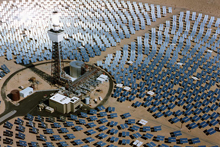Clean, renewable energy from the sun
It's 35 ˚C in the shade. Often.
In Upington, a town in the arid, ironed-flat expanse of the Northern Cape, the extreme and persistent heat may cause some to become hot and bothered, but to Eskom it's good news - because this is where the utility is considering building its electricity-from-the-sun project. (In fact, the Northern Cape every year records some of the highest aggregates of sunny days a year worldwide.)
|
If Eskom takes the decision to go ahead with the project, it will be the first major solar-energy project in Africa, especially where the electricity generated will be directed into the main power grid of a country.
It has been a long time in the making, with Eskom in 2001 already initiating a feasibility study to determine the choice between either a trough or central-receiver system for a 100-MW plant. In the end, the molten-salt type central-receiver technology was appointed the favourite.
In 2003, it was estimated that the project would cost around R2,2-billion. Now Eskom prefers not to talk about costs until a fresh feasibility study has been completed, this time specifically on the central-receiver system.
However, the cost of such a system may seem less severe these days, especially against the background of Eskom's preparing to fork out R97-billion in capital expenditure over the next five years as it moves ever closer to its maximum generation capacity as South Africans scurry for their heaters with each cold front.
But, yes, R2-billion-plus for 100 MW of electricity remains steep.
However, again, what makes electricity from the sun such a heavy- weight in the power-generation ring is that it is clean, renewable energy, unlike the electricity produced by South Africa's coal-fired power stations. These stations are currently used to produce more than 90% of South Africa's power - also churning out vast amounts of carbon dioxide and some other rather nasty pollutants.
Eskom's solar-power project is currently in the feasibility and environmental-impact assessment (EIA) phase. This is scheduled to be completed at the end of 2007, says Eskom resources and strategy division renewable-energy corporate specialist Dr Louis van Heerden.
"If approval is obtained, based on satisfactory results from the above phase, construction work can start as early as 2008," he tells Engineering News in an exclusive interview. The project has to satisfy three prerequisites before implementation, he notes, namely a positive record of decision on the EIA; resolving all outstanding technical issues; and an acceptable business case. The project will most likely be located in the Upington area, and will have a maximum capacity of 100 MW.
Van Heerden explains that central-receiver technology, which has now emerged centre stage, concentrates the sun's energy through multiple large mirrors, using the concentrated thermal energy to produce steam to drive a conventional steam turbine for electricity generation.
The energy concentration is achieved by a field of large sun-tracking mirrors (called heliostats), which reflect the sunlight to a receiver, mounted on a central tower in the middle of the mirror field.
A heat-transfer medium (molten salt) is pumped through the receiver, absorbing the highly-concentrated radiation reflected by the heliostats. The heated fluid is then circulated through a heat exchanger, where the thermal energy is used to generate steam and power a turbine. Temperatures within the system can reach in the region of 600 ˚C.
Central-receiver technology is only one of many renewable-energy options currently under investigation by Eskom, says Van Heerden. "However, given South Africa's significant solar resource, Eskom feels that this technology could potentially provide significant benefits into the future.
"Eskom has spent several years evaluating various concentrating solar technologies. The studies conducted have indicated that the central-receiver system has significant potential for local content in its manufacturing, as well as the highest potential for future cost reductions."
Cost is one of the pivotal issues around renewable-energy solutions, as they are not developed, researched or mass-produced on the same scale as conventional energy solutions, such as those around coal.
However, as resistance to pollution grows, so does the research, development and production of renewable-energy systems. The cost projection of the Upington project will be finalised through the feasibility phase, says Van Heerden.
However, it is anticipated that the generation cost will be substantially more than conventional methods currently in use in South Africa. (This is not surprising, as South Africa is currently credited with producing the world's cheapest electricity - which makes it a difficult fight for any alternative energy source to win.)
However, as renewable-energy pundits have often pointed out in the past, coal is a depleting feedstock, while sunlight is abundant, free, nonpolluting and, galactic disasters aside, not likely to run out.
Engineering News (Summary of original article).











